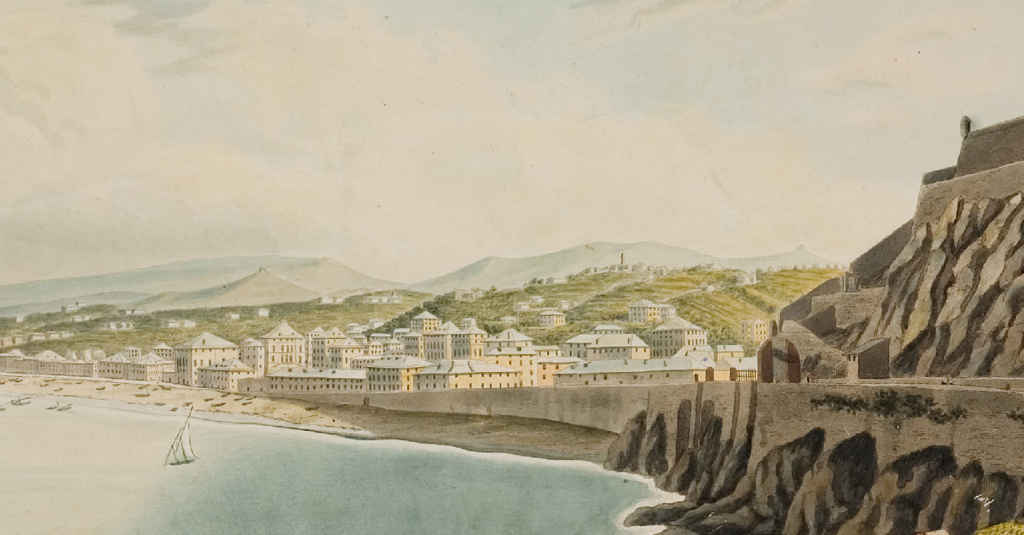Sampierdarena
(San Pier d’Arena)

In questa stampa acquarellata del 1814, Luigi Garibbo mostra Sampierdarena vista dagli scogli ai piedi della Lanterna. Un confronto con la realtà attuale mostra come sia radicalmente cambiato il contesto in cui ci troviamo: davanti all’abitato il mare è stato interrato per realizzare banchine, calate e piazzali portuali; i parchi e i giardini sono stati utilizzati per costruire moderni palazzi di abitazione. Esistono però ancora, anche se completamente decontestualizzate, quasi tutte le ville
// In this watercolour print dated 1814, Luigi Garibbo shows Sampierdarena as seen from the rocks at the foot of the Lighthouse. A comparison with today’s reality shows how radically the context has changed: in front of the city, the seashore has been covered over to build docks, piers and harbours; the parks and gardens now house modern residential buildings. However, almost all the villas still stand, although in an entirely different setting
Quando il Duca di Mantova vi veniva in villeggiatura…
San Pê d’ænn-a ovvero San Pier d’Arena (divenne Sampierdarena solo nel 1936), ricorda chiaramente nel nome la originaria presenza di una grande spiaggia di sabbia fine, amatissima nei secoli passati dai genovesi e anche ambita residenza estiva per personaggi di rilievo che intrattenevano rapporti con la Repubblica. Quando nell’estate del 1607 il duca di Mantova Vincenzo I Gonzaga venne a Genova per godere dei benefici del mare, vi giunse accompagnato da un nutrito seguito e fu ospitato in ben tre dei “palazzi di villa” di Sampierdarena, splendide dimore cinquecentesche che ancora oggi esistono, seppur nel trasformato contesto che si presenta proprio di fronte a voi. Il duca prese alloggio nella “Fortezza”, una delle dimore fuori le mura della famiglia Grimaldi. Insieme a lui era anche il giovane pittore fiammingo Pieter Paul Rubens, che già era stato a Genova varie volte e che in città aveva stretto legami di lavoro e amicizia con alcuni dei più importanti esponenti dell’aristocrazia locale: oltre a Carlo Grimaldi, a cui dedicherà anni a venire il suo libro sulle architetture genovesi, anche Nicolò Pallavicino, a cui fece fare da padrino di battesimo al suo secondo figlio, Nicolò Rubens, appunto.
San Pier d’Arena
The Duke of Mantua’s summer holiday
San Pê d’ænn-a or San Pier d’Arena (which only became Sampierdarena in 1936), literally means Saint Peter of the Sand, clearly recalling the original presence of a large sandy beach, much loved in past centuries by the Genoese and a sought-after summer holiday destination for prominent figures with close ties to the Republic. When the Duke of Mantua Vincenzo I Gonzaga came to Genoa in the summer of 1607 to enjoy the fresh sea air, he was accompanied by a large entourage which was housed in no less than three of Sampierdarena’s “palazzi di villa”, splendid 16th century homes that you can see still standing before you, albeit in a very different context. The Duke stayed in the ‘Fortezza’, one of the Grimaldi family’s holiday residences. He was accompanied by the young Flemish painter Pieter Paul Rubens, who had already visited Genoa several times forging close business relations and friendships with some of the most important members of the local aristocracy: Carlo Grimaldi, to whom he dedicated his book on Genoese architecture years later, and Nicolò Pallavicino, whom he chose as godfather for his second son, Nicolò Rubens.
